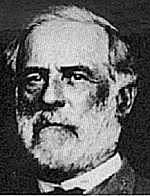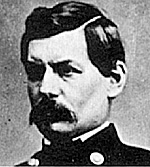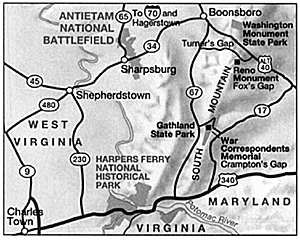 Fresh from the victory at Second Bull Run, Confederate General Robert E. Lee (at right) wrote to President Jefferson Davis, "We cannot afford to be idle, and though weaker than our opponents...we must endeavor to harass them if we cannot destroy them." Soon, the 50,000 ragged soldiers of the Army of Northern Virginia marched northward across the Potomac River and into Maryland on September 4, 1862.
Fresh from the victory at Second Bull Run, Confederate General Robert E. Lee (at right) wrote to President Jefferson Davis, "We cannot afford to be idle, and though weaker than our opponents...we must endeavor to harass them if we cannot destroy them." Soon, the 50,000 ragged soldiers of the Army of Northern Virginia marched northward across the Potomac River and into Maryland on September 4, 1862.
 The defeated Union General of Second Bull Run, John Pope, was replaced September 2 by General George McClelland (at left), back from his own inactions in front of Richmond on the Peninsula. But whatever his faults in the field, he soon reorganized the Union Army of the Potomac, restored the morale of the troops, and began pursuit of Lee's army. By the 7th, McClelland had moved his headquarters from Washington DC to Rockville, MD.
The defeated Union General of Second Bull Run, John Pope, was replaced September 2 by General George McClelland (at left), back from his own inactions in front of Richmond on the Peninsula. But whatever his faults in the field, he soon reorganized the Union Army of the Potomac, restored the morale of the troops, and began pursuit of Lee's army. By the 7th, McClelland had moved his headquarters from Washington DC to Rockville, MD.
Lee advanced to Frederick, MD on September 7, then headed west through the South mountains. While in Frederick, Lee fashioned his plans to open up the Shenandoah Valley, perhaps heading as far north as Harrisburg, Pennsylvania. Once through Crampton's Gap, Lee would split his army in two--just as he had done at Second Bull Run--sending Gen. Stonewall Jackson south to Harper's Ferry to eliminate its 12,000-man Union garrison while he turned north towards Hagerstown. MD. He was gambling that he could combine his divided army before the reinvigorated Union army could catch them.
If Lee had hoped to propel Maryland into the Confederacy and gain valuable recruits, he was severely disappointed. Of more importance and more disappointment, Lee learned that his Special Order 191, crafted on September 9 and outlining his plans, had been found by Union soldiers at an abandoned Confederate campsite. The order, one of seven, was found wrapped around three cigars on Sept 13 by Private Barton Mitchell, sent through the chain of command until it reached McClelland. "Little Mac" joyously waved the papers, thundered, "Here is a paper with which, if I cannot whip Bobby Lee, I will be willing to go home," and promptly spent the better part of the day thinking about marching rather than getting his troops into motion.
South Mountain Gaps
 On the 14th, the Union army attempted to force various gaps in the South Mountains. Although stymied elsewhere, the Union VI Corp finally broke Crampton's Gap, but instead of relieving the Confederate siege of Harper's Ferry as McClelland ordered, General William Franklin halted. Lee pulled his troops back.
On the 14th, the Union army attempted to force various gaps in the South Mountains. Although stymied elsewhere, the Union VI Corp finally broke Crampton's Gap, but instead of relieving the Confederate siege of Harper's Ferry as McClelland ordered, General William Franklin halted. Lee pulled his troops back.
Franklin's delay proved fortuitous for Stonewall Jackson, whose three columns had encircled Harper's Ferry by the 13/14th. On the morning of the 15th, Jackson unleashed an artillery bombardment from the surrounding hills in preparation for a general assault. The Union garrison commander, Dixon S. Miles, known as a heavy drinker (he was relieved of command at First Bull Run in 1861 on charges of drunkenness) and who may have been drunk during the siege, ordered the garrison to surrender. Miles did not live to see it, being killed just as the white flag was run up. Over 10,000 men, 13,000 small arms, 73 cannon, and various other supplies fell into Confederate hands.
Jackson left AP Hill's division behind to tally the haul and marched to join Lee at the small town of Sharpsburg, MD, 17 miles to the north. Lee had arrived on the 15th, taking a position on the ridge overlooking Antietam Creek, with Jackson arriving by the 16th after a grueling march. It was not a particularly optimal position, with a single ford over the Potomac River at his back, but it would have to do.
McClelland's 87,000 troops began arriving on the east side of the Creek on the 15th, but "Little Mac" tarried yet again on the 16th, allowing Jackson's men time to rest and refit, and Lee to gather additional scattered forces to bring his force up to about 40,000--as well as send word to General AP Hill to march to Sharpsburg on the double.
At dawn on September 17, 1862, McClelland launched the Union Army of the Potomac against Lee's Army of Northern Virginia. The plan was relatively simple: I (Hooker) and XII (Mansfield) on the Union right would attack in the north against the Confederate left flank, supported by II Corp (Sumner), with the idea of rolling up the Confederate line. IX Corp (Burnside) would launch a pinning attack on the Confederate left, leaving a center reserve that McClelland would commit if needed.
Antietam
-
Introduction to Antietam Battlefield
The Campaign
Morning Phase: The Cornfield
Midday Phase: Bloody Lane (Sunken Road)
Afternoon Phase: Burnside's Bridge
Conclusion: Aftermath
Back to List of Battlefields
Back to Travel Master List
Back to MagWeb Master List of Magazines
© Copyright 1997 by Coalition Web, Inc.
This article appears in MagWeb (Magazine Web) on the Internet World Wide Web.
Other military history articles and gaming articles are available at http://www.magweb.com